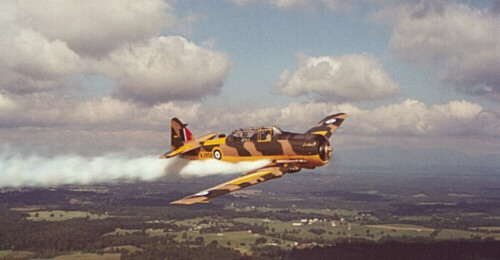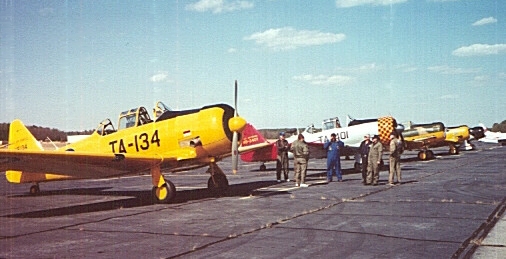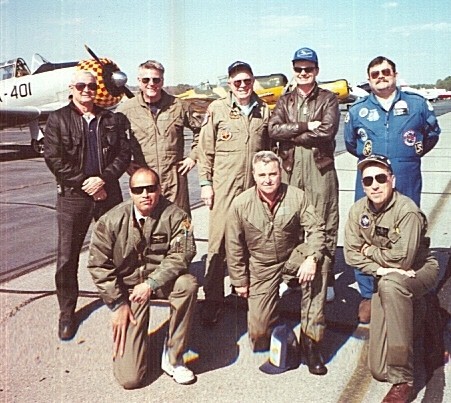
Photo by Brian Nicklas
Warbird Alley
Special Feature
Formation and Safety Training (FAST) Clinic,
Petersburg, Virginia, USA

Photo by Brian Nicklas
| by John
"Skipper" Hyle Photos by Col Susan Northrup, Commemorative Air Force (except where noted.) Part of the enjoyment of flying warbirds
is the camaraderie associated with the people around them. When we get other people
involved, including our families, it keeps the movement going. (It also keeps the
Commander-In-Chief of the House -- the wife -- happy.) That's one of the reasons the
National Capital Squadron (NCS) of the Confederate Air Force (CAF) held a FAST Clinic at
Petersburg, Virginia, in March 2001. |
What is FAST? FAST is an administrative body
made up of a group of signatory organizations which provides the standard for civilian
formation flying of warbirds. In order for a pilot to fly in formation in waivered
airspace (i.e. an airshow), pilots must hold a FAST card, certifying they have received
the appropriate amount of flight instruction, and are competent and safe. |

Looking pretty on the flightline are: Matt Bennett's T-6,
Ray Reese's T-6,
John Hyle's Harvard, John Koelbel's Harvard, and the Val, flown by John Fuentes.
| Thanks to some great weather, nearly everyone
was able to arrive on Friday, the 23rd of March, 2001. That afternoon we held ground
school. For some "students" it was a review, and for others it was their first
discussion of pursuit curves, overtake, closure, and an explanation of the formation
rejoin "sight picture." Ground school is very important -- at least as important as the flight training itself! As anyone who has flown formation will tell you, there is a lot going on in the average aircraft formation, especially if it's your first time doing it. And for those pilots with military formation time, a FAST clinic is a chance to realize that civilian hand-signals and aircraft signals are a conglomeration of signals from each of the services. You have to learn to be bilingual. |
A two-ship gets ready to launch.
| On Saturday, we split into two-ship formations
and faced a stiff west wind. (At least it was blowing straight down the runway.) It was
not the best day to fly formation, but everyone learned something and gained confidence
operating their aircraft in such conditions. Also on Saturday morning, the NCS, along with other local units of the CAF, began the Marshalling Ground School, taught by Scott Parks of the CAF Marshalling Detachment. The "orange shirts," as they are known, represent a wonderful opportunity for those who do not fly to work around the aircraft, and the training provided at the clinic was a great chance for the local units to gear up for the summer airshow season. NCS Participants were: Anna Othold, Ron Gill, Don Weeks, Pat Kraus, and Al Shirley; Delaware Valley Wing participants were Allex Grella and Carl Denslow; and the Old Dominion Squadron was represented by Bill Bean. |
The marshallers practice waving their arms.
| That night was "Beer Call." My wife, who is also a CAF Colonel and NCS member, brought some great beef and seafood, which we cooked on the grill. Everyone was well-fed, including the airport ramp guys. The rest of the evening was spent hangar-flying, shooting down our watches, listening to tales of Tad and Sid's A-4 Skyhawk and Aviation Cadet days, and all the while listening to tapes of old fighter pilot songs sung by Dick Jonas. Paradise! |
John Fuentes removes the Val's canopy cover and prepares to
fly.
| Sunday dawned clear and much calmer, so we launched into the blue again. This time we not only worked on two-ship formations, but also three-ship. The weekend went too quickly, and soon it was time for instructors and warbird owners alike to return to their weekday lives. All in all, an enjoyable and educational way to spend three days. |
John Koelbel attends to one of the numerous preflight tasks
a 50 year-old aircraft requires.
| Flying these old airplanes is many things to many people. As a former F-16 pilot, it takes me back through history: Rickenbacker in his SPAD; the "few" owed so much by Britain; the few Wildcats which protected Henderson field that fateful December morning; the formations of Mustangs and T-Bolts going all the way to Berlin; Sabres roaming the Yalu and experiencing a 15:1 kill ratio; Thud drivers going downtown to battle both SAMs and politicians; and a 100-day air campaign which unleashed a storm in the desert and made it much easier for the "grunts" to do their jobs. Flying these airplanes is history alive. There's no sound like a Merlin's purr or the cough and sputter of an R-2800 radial starting up. People who attend airshows get to hear the sound and feel the vibration, unlike a static museum display. |
Ray Reese and his T-6G.
| These old airplanes require the same professional attitude that was requires of the first young men who flew them. Formation flying, in particular, requires large doses of professionalism in addition to raw skill. The FAST program instills that discipline to owners and operators who haven't had it instilled by the military. It also provides a lot of fun and a sense of "squadron" camaraderie, something most of us ex-military guys don't find in any other employment outside of the military services. |
John Hyle leads a formation out of the parking area in his
Harvard.
| Formation flying is a perishable skill, like instrument flying. If you own or fly a warbird, I urge you to attend a FAST clinic. Stay current and enjoy these old, special aircraft and the people who fly them. |

Participants in the March 2001 FAST clinic
at Petersburg, Virginia.
Kneeling (L to R): Tom Malone, John Koelbel, John Fuentes.
Standing (L to R): Sid Snedeker, Ray Reese, Tad Foran, Matt Bennett, and John Hyle.
© 2002 The Doublestar Group
All Rights Reserved
Photos and text used with permission.